Austria is a small country in central Europe famous for its beautiful mountain scenery. The towering Alps and their foothills stretch across the western, southern, and central parts of the country. In many areas, broad, green valleys separate the mountains. Austria has many lovely, mirrorlike lakes. Thick forests cover much of the land.

Austria has no coastline. It shares boundaries with the countries of Switzerland and Liechtenstein to the west, Germany and the Czech Republic to the north, Slovakia and Hungary to the east, and Slovenia and Italy to the south.
Vienna is the capital and largest city of Austria. It lies on the Danube River in the northeastern part of the country. Most of Austria’s people live in cities and towns.

Austrians take great pride in the fact that their country has long been a leading cultural center of Europe. The cultural institutions and scenic beauty of Austria attract tens of millions of tourists each year.
Austria was once the core of one of the great powers of Europe. Austria began as a military border territory of the Holy Roman Empire in the late 900’s and became a duchy (territory ruled by a duke) of the empire in 1156. In the late 1200’s, the Habsburg (also spelled Hapsburg) family gained control of Austria and became identified with Austria. The House of Habsburg, also known as the House of Austria, developed into the most powerful dynasty in the empire. From 1438 to 1806, except from 1740 to 1745, the Habsburgs ruled the empire. The Holy Roman Empire ended in 1806, and the Austrian Empire, founded in 1804, replaced it. The Austrian Empire became the Dual Monarchy of Austria-Hungary in 1867. This kingdom split into several states at the end of World War I in 1918, with the territories of present-day Austria forming the Austrian republic. The republic endured two decades of economic difficulty and political unrest.

From 1938 to 1945, Austria was part of the German Third Reich (Third Empire), the Nazi term for the empire in which they hoped to unite all Germanic peoples. After Germany’s defeat in World War II (1939-1945), the Allies occupied Austria until 1955. Since then, Austria has been a neutral country. It has benefited from both economic and political stability and has become a prosperous nation. In 1995, Austria joined the European Union (EU), an organization of European nations that works for economic and political cooperation among its members.
Government
Austria is a federal republic made up of nine provinces: Burgenland, Carinthia, Lower Austria, Salzburg, Styria, Tyrol (or Tirol), Upper Austria, the city of Vienna, and Vorarlberg. Austria’s Constitution was adopted in 1920. All Austrian citizens who are 16 years and older may vote.
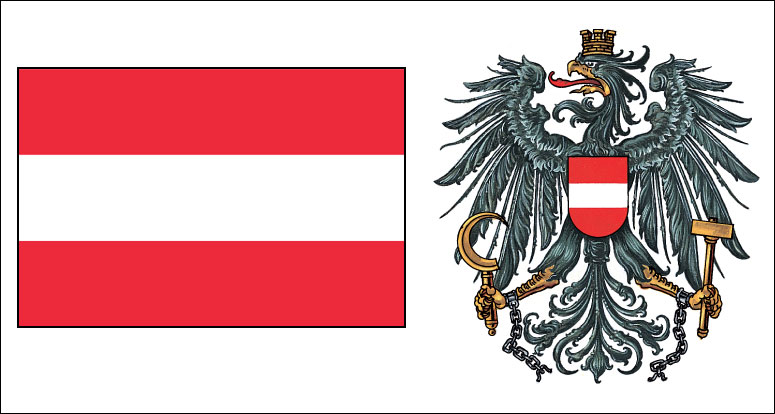
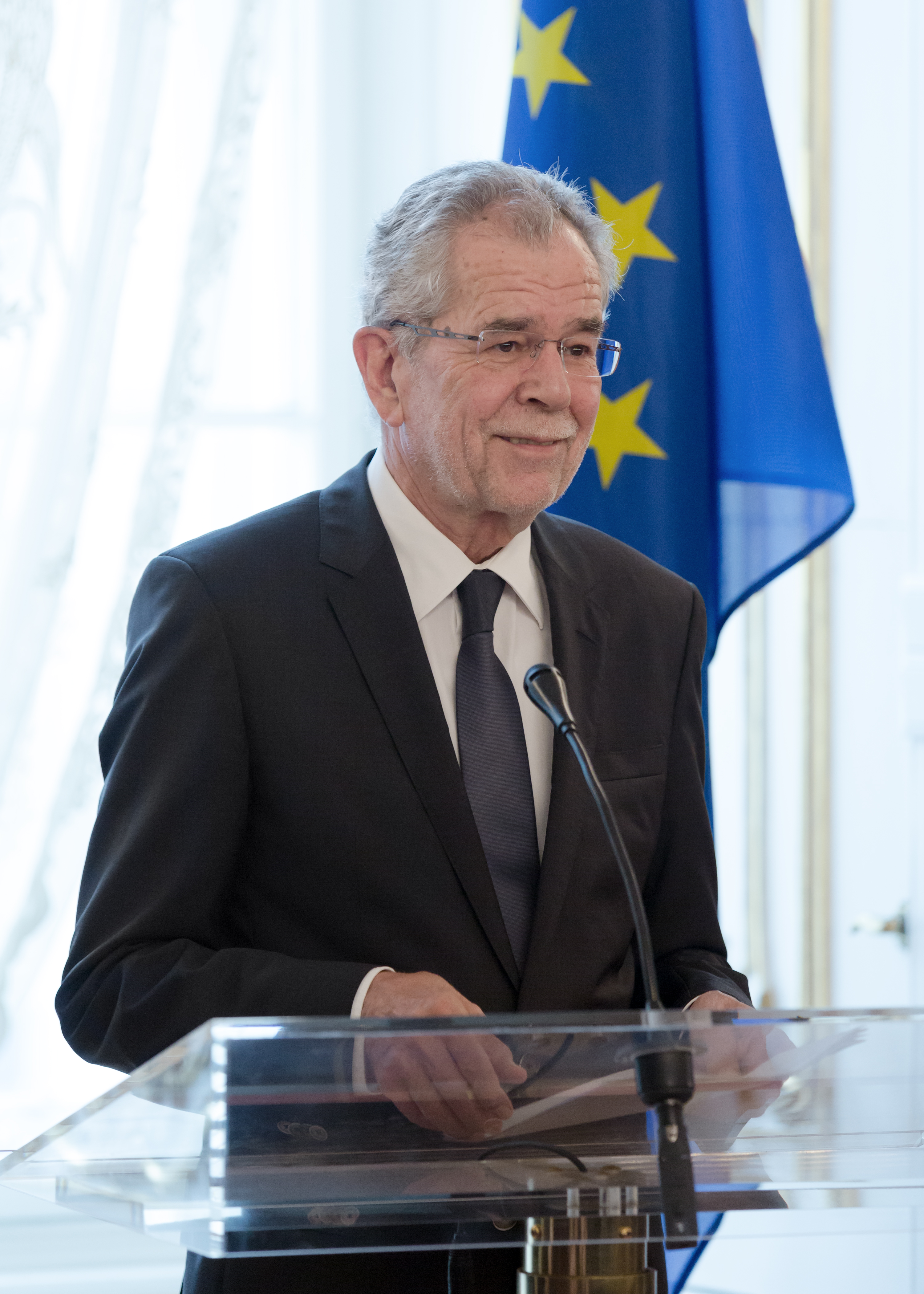
Austria's national anthem
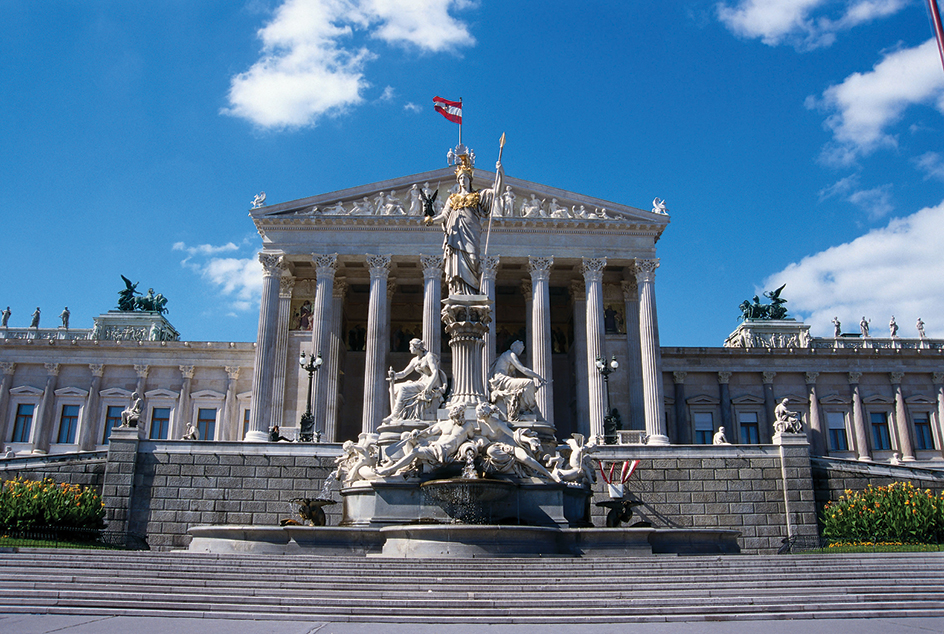
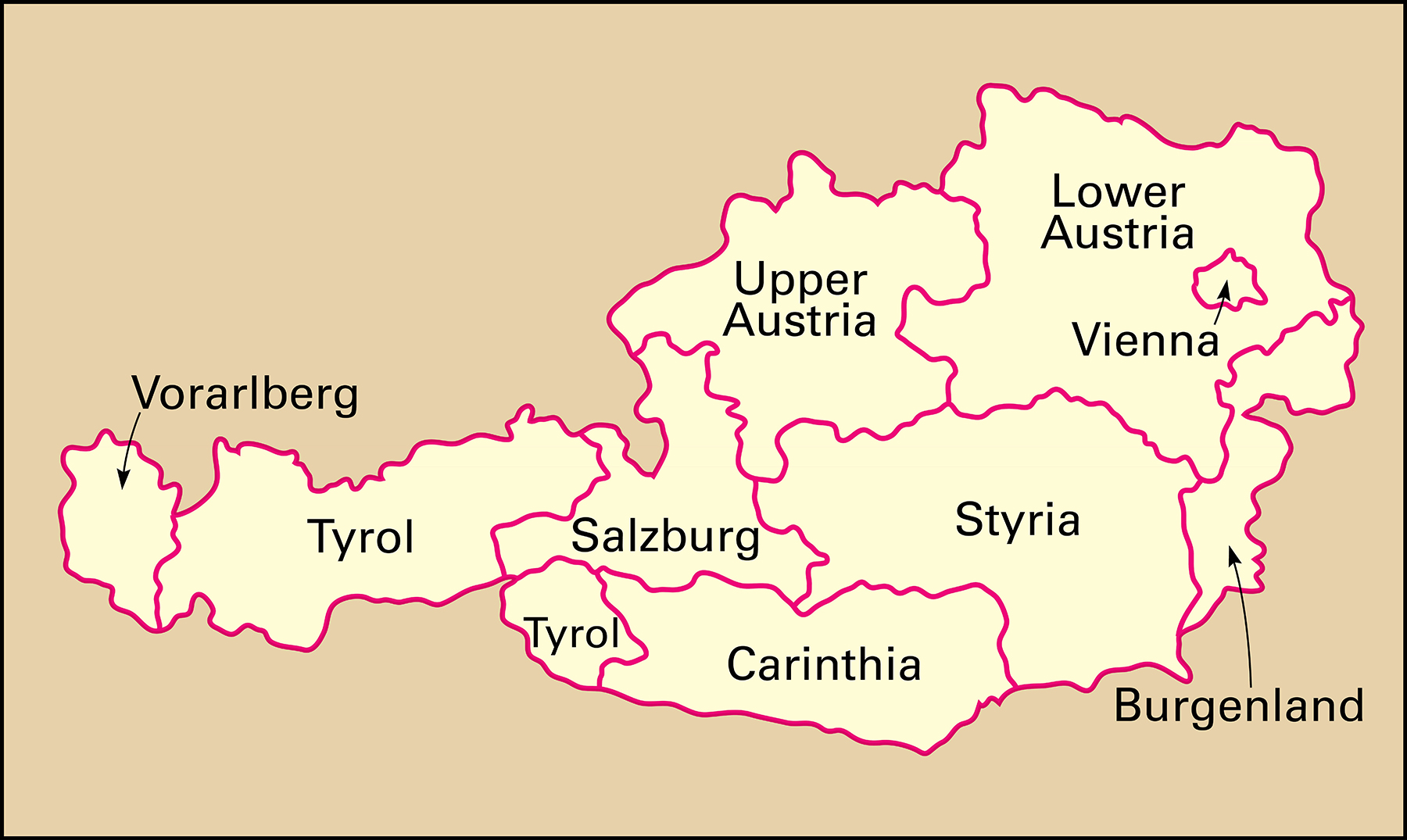
The president
is Austria’s head of state. The people elect the president to a six-year term. The president may serve any number of terms but no more than two in a row. The president’s duties include appointing ambassadors, signing treaties, and swearing in certain officeholders. The president also acts as commander in chief of the armed forces. The president does not have the power to declare war or to veto (reject) bills passed by Austria’s parliament, the Federal Assembly.
The chancellor and Council of Ministers
run the Austrian government. The chancellor (prime minister) serves as head of government. Generally, the president appoints as chancellor the leader of the political party with the most seats in the Nationalrat. The Nationalrat is the more important of the two houses of the Federal Assembly. On the chancellor’s advice, the president also appoints members of the Council of Ministers to head the government departments. The chancellor and Council of Ministers set government policies and are responsible to the Nationalrat. The Nationalrat may force the chancellor and Council of Ministers to resign by rejecting their policies in a vote of no confidence.
The Federal Assembly
consists of two houses, the Nationalrat (National Council) and the Bundesrat (Federal Council). Members of the Nationalrat are elected by the people to five-year terms. But new elections may take place sooner if the Nationalrat dissolves itself, or if the president dissolves it on the chancellor’s advice. The Bundesrat’s members are elected by the country’s nine Landtags (provincial legislatures). Members of the Bundesrat serve as long as the Landtag that chose them stays in power. The number of members a province has in the Bundesrat varies according to population.
Provincial and local government.
The people in each province elect Landtag members to terms of up to five or six years, depending on the province. Each Landtag chooses the governor of the province. The provinces are subdivided into more than 2,000 municipalities (units of local government). Voters in each municipality elect a governing council, which selects one of its number to serve as mayor. Vienna is both a province and a municipality. Its municipal council serves as the provincial legislature, and its mayor serves as governor.
Political parties.
Two political parties have traditionally controlled the great majority of seats in the Nationalrat. They are the center-left Social Democratic Party of Austria and the conservative Austrian People’s Party. Other parties include the environmentalist Greens and the far-right Freedom Party of Austria.
Courts.
The Supreme Court of Justice is Austria’s highest court of appeal in civil and criminal cases. The Supreme Constitutional Court determines whether laws are constitutional, and the Supreme Administrative Court is the highest court for cases that challenge the activities of government agencies. Four provincial courts hear appeals of decisions made by lower courts. Various special courts handle juvenile matters and labor disputes.
Armed forces.
Austria’s armed forces consist of an army with an air wing but no navy. Austrian men must serve at least six months in the army, usually with additional periods of follow-up training later. Women serve in the armed forces on a voluntary basis.
People
Most of Austria’s people live in the lowland areas of the country—in the east and just south of the Danube River. About a fifth of the people live in Vienna, the country’s capital and largest city.
Ancestry.
Many different groups of people have settled in Austria. Each group mixed with other people and so helped shape the ancestry of present-day Austrians. In ancient times, the people of Austria included Celts and Romans. Later, various Germanic and Slavic groups settled in Austria. After the 1300’s, Austria attracted people from many parts of central Europe and parts of the Habsburg empire, such as Italy and Spain. Many immigrants came to Austria during the Cold War, the rivalry between Communist and non-Communist nations that lasted from the late 1940’s to the early 1990’s. Large numbers of people fleeing from Communism in Czechoslovakia and Hungary settled in Austria. In the 1990’s, the tensions surrounding the breakup of Yugoslavia led some people from that region to immigrate to Austria.
Language.
Almost all Austrians speak German, the country’s official language. In different parts of the country, the people speak various dialects (local forms) of German.
A number of Austrians speak another language as their first language. In the province of Burgenland, for example, there are communities of people who speak Croatian. Carinthia has a number of people who speak Slovenian. Small groups of people in Vienna speak either Czech or Slovak. Other languages spoken as a first language include Magyar (also called Hungarian), Serbian, and Turkish.
Way of life.
Most city dwellers in Austria live in apartment buildings. Others live in single-family homes. Many farm and village families live in single-family homes. Housing styles vary from region to region. In Burgenland, many homes are simple in design and covered with a kind of plaster called stucco. The provinces of Tyrol and Vorarlberg have many wooden houses called chalets similar to those of Switzerland. Most chalets have a steep, pointed roof with wide, overhanging eaves.
Austrians wear clothing much like that worn in other European countries and in North America. On special occasions, many Austrians wear traditional national or regional costumes. Men may wear a green-trimmed, gray wool suit consisting of a coat and knickers—short, loose-fitting trousers gathered just below the knee. Women may wear a peasant costume called a dirndl, which has a full skirt, an apron, and a close-fitting top that is worn over a blouse and laced up the front.
Many Austrian dishes have been influenced by Czech, German, or Hungarian cooking. Popular meats in Austria include beef, chicken, pork, sausage, and veal. An Austrian dish called Wiener schnitzel (breaded veal cutlet) has become a favorite in many countries. Popular side dishes in Austria include dumplings, noodles, and potatoes. Austrians drink beer or wine with many meals. The delicious cakes and pastries created by Austrian bakers have become world famous. 
Festivals and holidays play an important part in Austrian life. Some festivals date from pre-Christian times. One such festival held in parts of the Tyrol has become part of the late winter merrymaking that precedes the solemn religious season of Lent. Some people pretend to chase away the “evil spirits” of winter. Wearing special costumes and masks, they march through the streets and wave large sticks in the air. Loading the player...
Austrian folk march
Social welfare.
The Austrian government provides comprehensive welfare services. Under the national social insurance program, workers may receive disability, maternity, old-age, sickness, survivors’, or unemployment benefits. Austria also has a national health insurance program for all citizens. The costs of both programs are shared by insured people; employers; and the federal, provincial, and local governments.
Since 1919, Austrian law has limited the workday to eight hours and has guaranteed employed people annual holidays. Today, most employed people who have been on the job for one year or longer receive at least a 25-day vacation with pay each year. In 1975, the workweek became limited to 40 hours.
Recreation.
Austrians love the outdoors, and their country’s many forests, lakes, and mountains offer opportunities for a variety of outdoor sports. In winter, the people especially enjoy ice skating, skiing, and tobogganing. Other popular winter sports include bobsledding, ice hockey, and ski jumping. Favorite summer sports include boating, fishing, hiking, mountain climbing, swimming, and water skiing. The people also enjoy bicycling, camping, picnicking, and playing soccer. 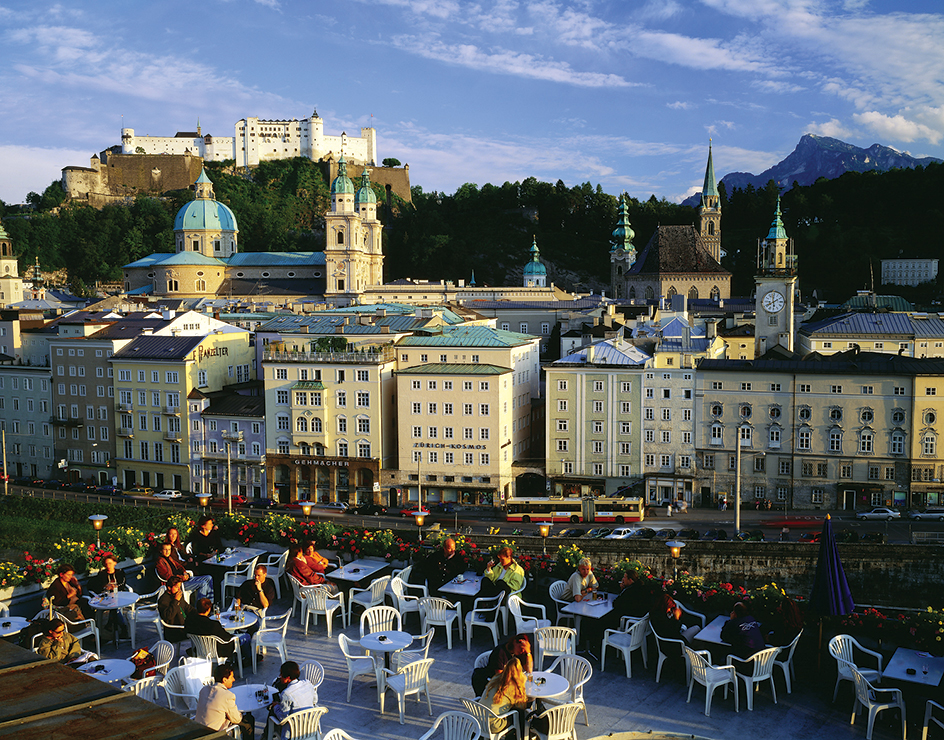
Austrians love the arts as well as sports. Ballets, concerts, motion pictures, operas and operettas, and plays are all popular.
Education.
Almost all adult Austrians can read and write. Austrian children between the ages of 6 and 15 are required to attend school. Most students attend free public schools. The rest attend private schools, which may charge a tuition fee.
Austria has several universities, technical colleges, and fine arts colleges. The University of Vienna is the country’s largest university. 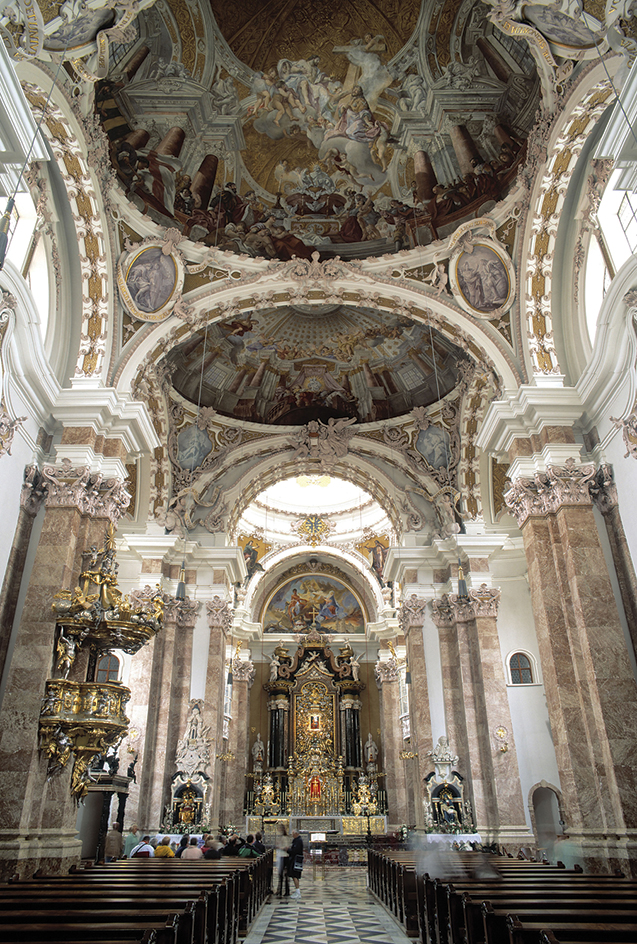
Religion.
About half of Austria’s people are Roman Catholics. Muslims account for about 10 percent of the population and Protestants about 5 percent. Austria has a small Jewish population, mostly in Vienna. The Austrian government gives financial support to many religious institutions, including the private schools of the Roman Catholic Church and several other recognized religions.
The arts.
Austria has been a leading cultural center in Europe. The country has made outstanding contributions in architecture, literature, painting, and theater. However, Austria’s most important cultural achievements have been in music.
Music.
Austria has produced many great composers. During the late 1700’s and early 1800’s, Joseph Haydn helped make the symphony one of the most important forms of musical composition. Haydn and Wolfgang Amadeus Mozart became the leading composers of the Classical period of music. Mozart wrote masterpieces in a wide range of musical forms. Many people consider his Don Giovanni (1787) the world’s greatest opera. 
The German composer Ludwig van Beethoven spent most of his life in Austria. Most of his nine symphonies and his opera, Fidelio (three versions: 1805, 1806, 1814), were composed and first performed in or near Vienna. In the early 1800’s, Franz Schubert of Vienna created chamber music, symphonies, and over 600 lieder (German-language art songs). Hugo Wolf continued the lieder tradition in the late 1800’s. Gustav Mahler and Anton Bruckner wrote many symphonies, which are considered some of the finest Austrian contributions to music during the Romantic era. Johannes Brahms, a German composer who combined the Romantic and Classical traditions, also lived in Vienna. Johann Strauss and his son, Johann Strauss, Jr., composed their famous waltzes and operettas in Vienna.
Arnold Schoenberg became one of the most revolutionary composers of the 1900’s. He developed a new system of composition called the twelve-tone technique. Schoenberg influenced many composers, including his fellow Austrians Alban Berg and Anton Webern.
Austria today continues to make important musical contributions. The Vienna Boys’ Choir, Vienna Philharmonic, Vienna State Opera, and Vienna Symphony have achieved international fame. The annual Salzburg Festival is one of the great musical events of the year. Students from all over the world study at Austria’s fine music schools. 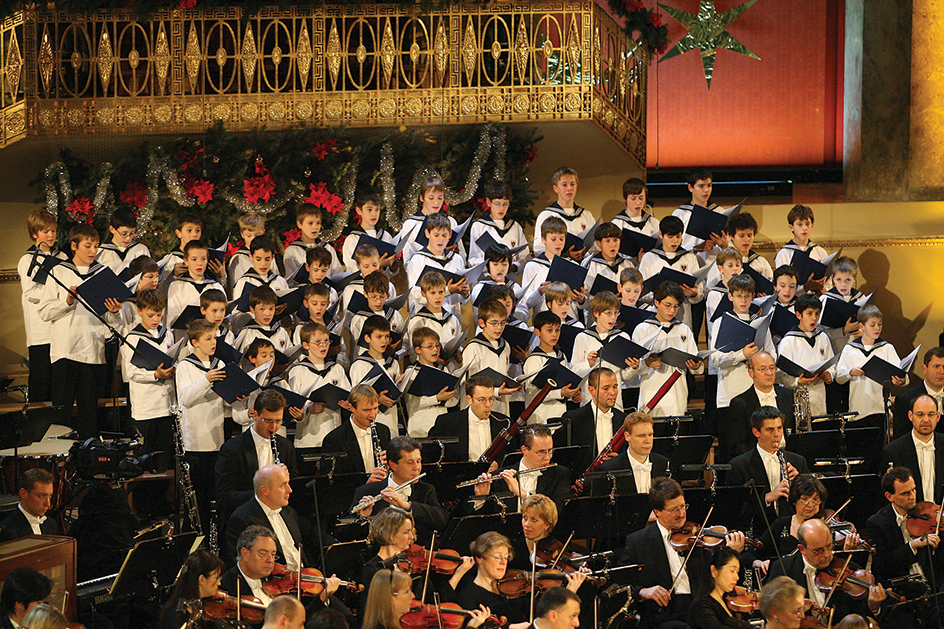
Architecture.
Austria has some of Europe’s best examples of Baroque architecture. Beginning in the 1600’s, buildings in the Baroque style featured elaborate decorations and an abundance of paintings and sculptures. The architects intended these buildings to express the power and glory of the Roman Catholic Church, the Austrian aristocracy, and the Habsburg dynasty. The finest examples of Austrian Baroque architecture include the Karlskirche (Church of St. Charles, named for St. Charles Borromeo) in Vienna and the Church of the Holy Trinity in Salzburg. Johann Bernhard Fischer von Erlach designed both churches. Other examples include the Belvedere Palace in Vienna, designed by Johann Lucas von Hildebrandt, and the Benedictine monastery in Melk, designed by Jakob Prandtauer. 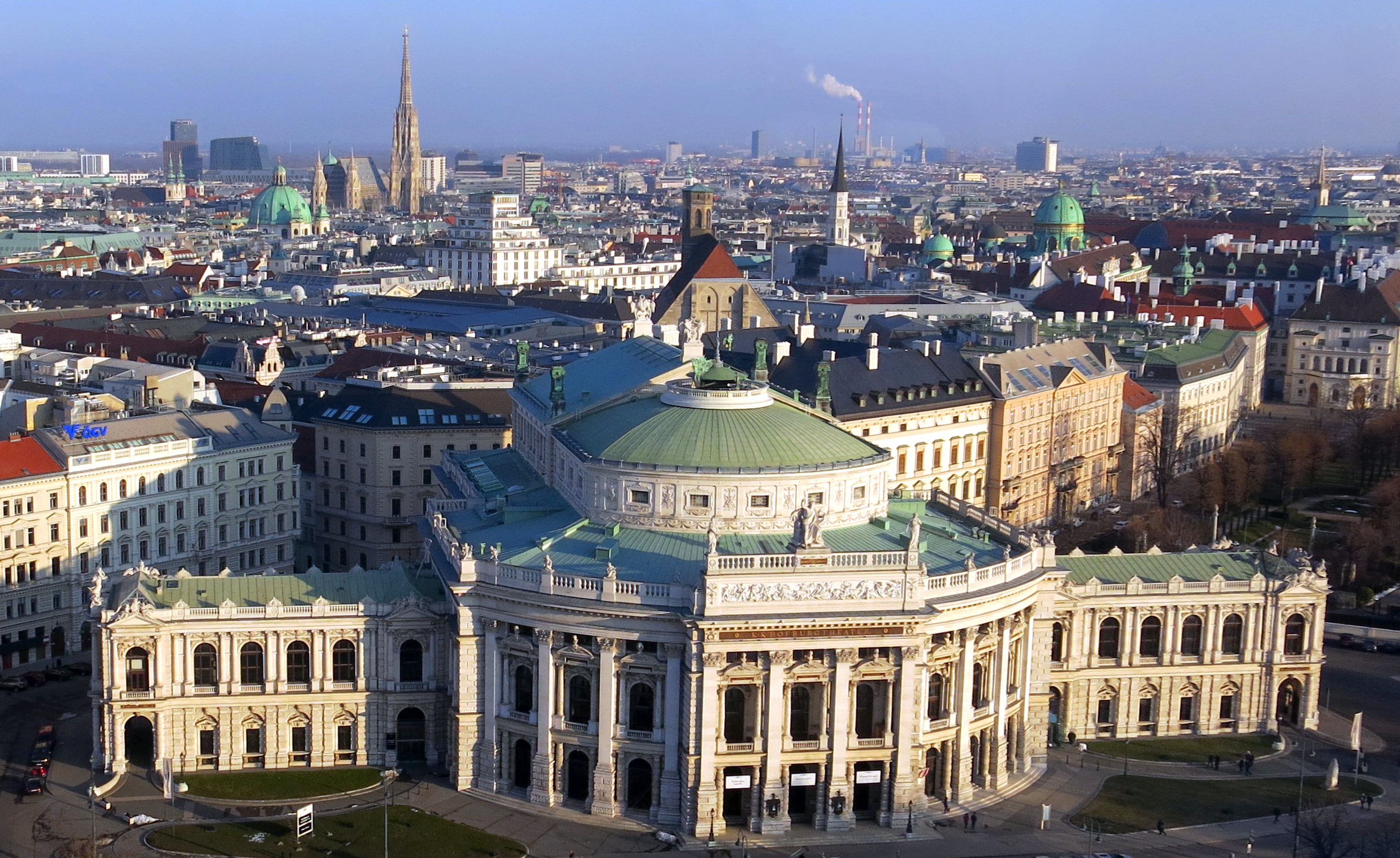
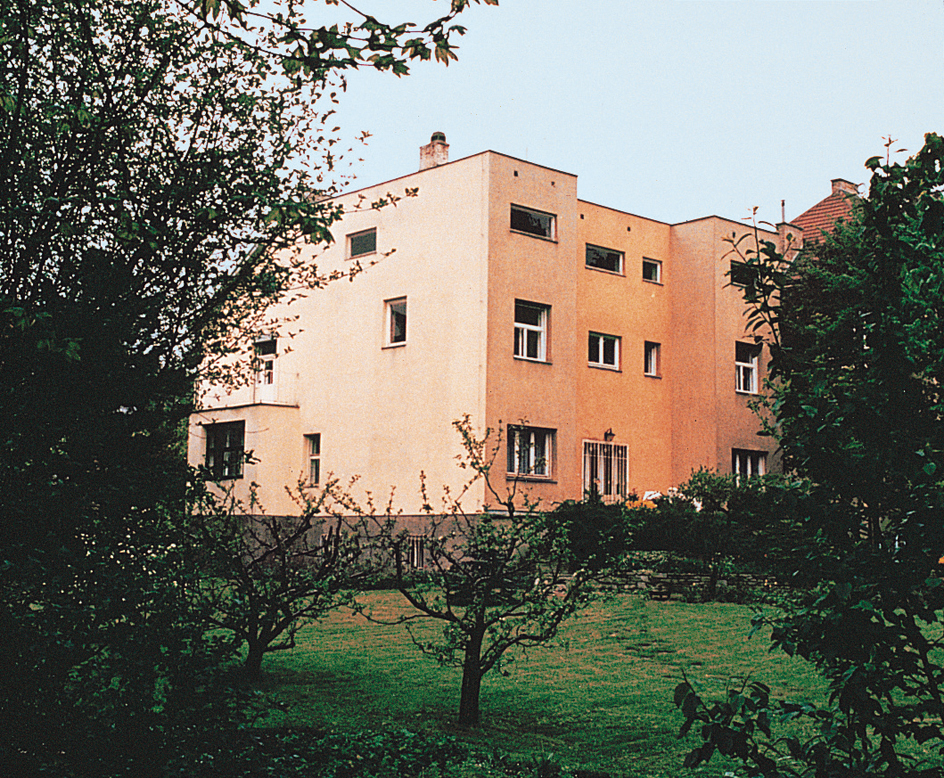
Austria also has many churches, palaces, and other buildings designed in the Rococo style of the 1700’s. Rococo architecture is even more decorated than Baroque, but lighter.
During the late 1800’s and early 1900’s, Otto Wagner developed a simplified, functionalist style of architecture, based on the belief that a building’s function should determine its style. Adolf Loos further developed this architectural functionalism. Wagner and Loos are regarded as two of the founding figures of the Modern Movement in architecture.
Literature.
People in Austria love the theater, and many of the country’s most important writers have been playwrights. Franz Grillparzer wrote plays in the early to middle 1800’s that drew on classical German drama as well as Austrian folk plays. Ferdinand Raimund wrote plays in the folk tradition with elements of fairy tales, while Johann Nestroy wrote political satires often disguised as fantasies.
During the late 1800’s and early 1900’s, such writers as Arthur Schnitzler and Hugo von Hofmannsthal created a Viennese literary tradition famous for its artistic style and psychological depth. Such authors as Robert Musil, Franz Werfel, and Stefan Zweig further developed this tradition of psychological fiction. These authors of such fiction were inspired partly by the theories of Sigmund Freud, the Austrian physician who developed psychoanalysis as a method of treating mental illness. Karl Kraus became one of the greatest satirists of the early 1900’s. In 2004, Elfriede Jelinek became the first Austrian writer to receive the Nobel Prize in literature. 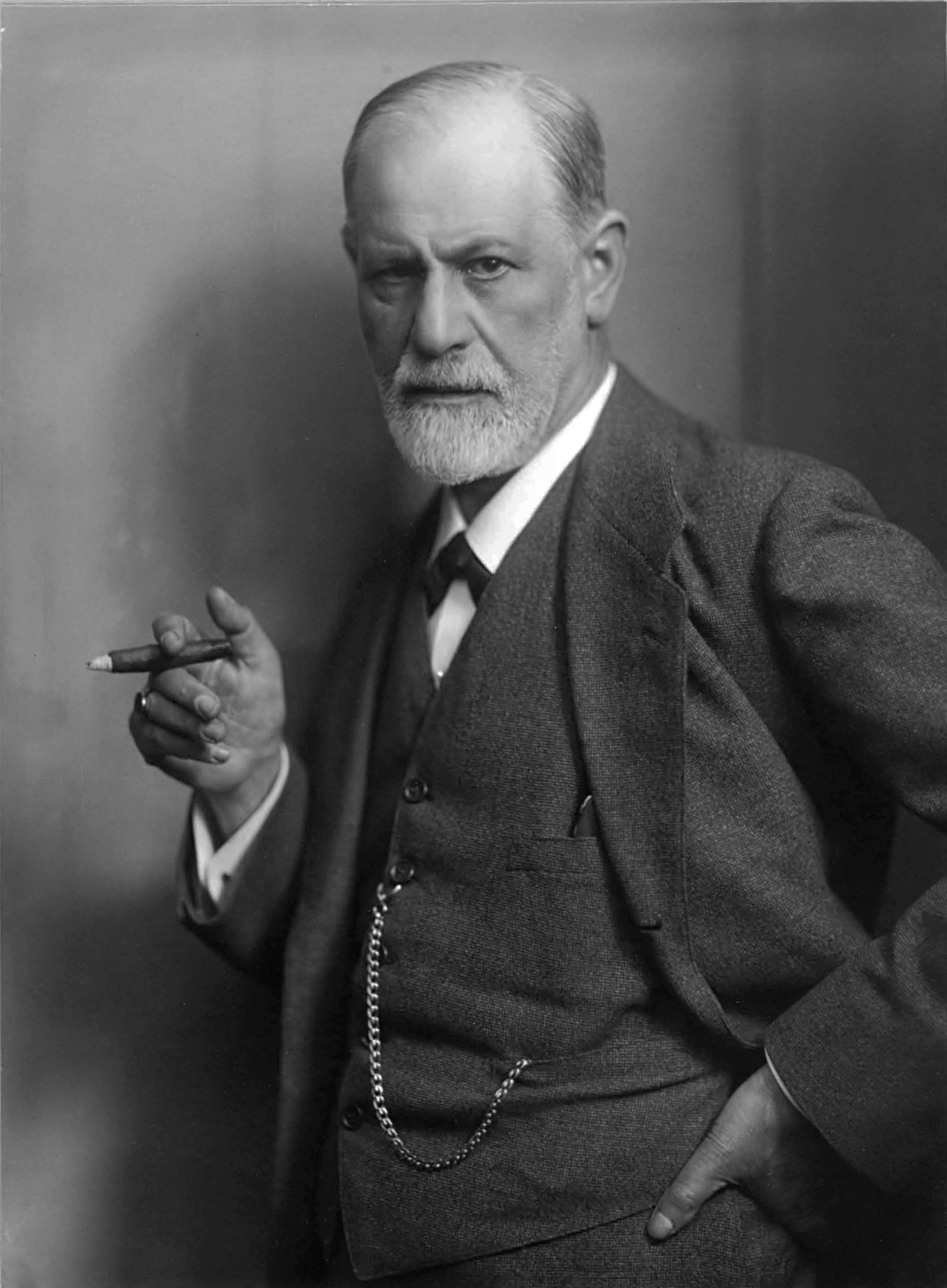
Painting.
Gustav Klimt, who worked in the late 1800’s and early 1900’s, was one of Austria’s first modern painters of international importance. He is known for his flat, two-dimensional, decorative portraits. Two of Klimt’s followers—Egon Schiele and Oskar Kokoschka—became the leading artists of Austrian Expressionism, a movement that emphasized strong emotional content.
Land and climate
Mountains cover about three-fourths of Austria. The Alps stretch across the western, southern, and central parts of the country. A separate mountainous area, the Granite Plateau, lies in the north. The country’s highest point, the mountain Grossglockner, rises 12,461 feet (3,798 meters) above sea level in central Austria.
Loading the player...
Austrian castle
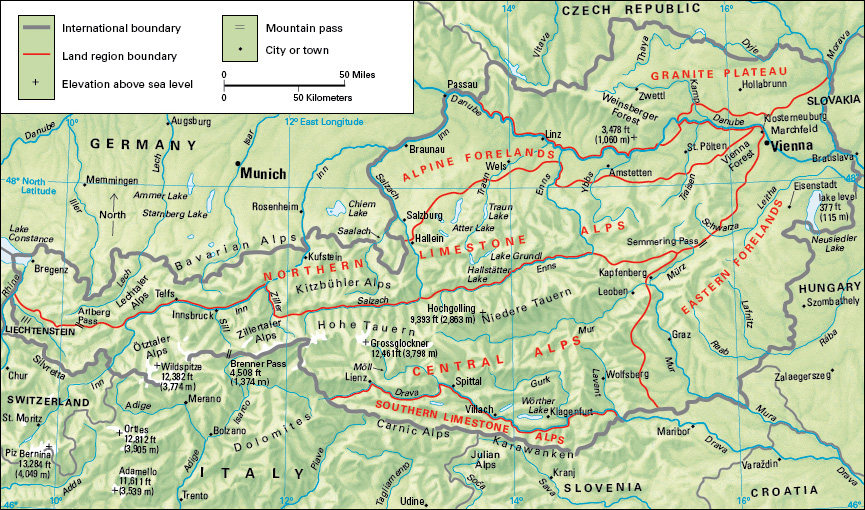
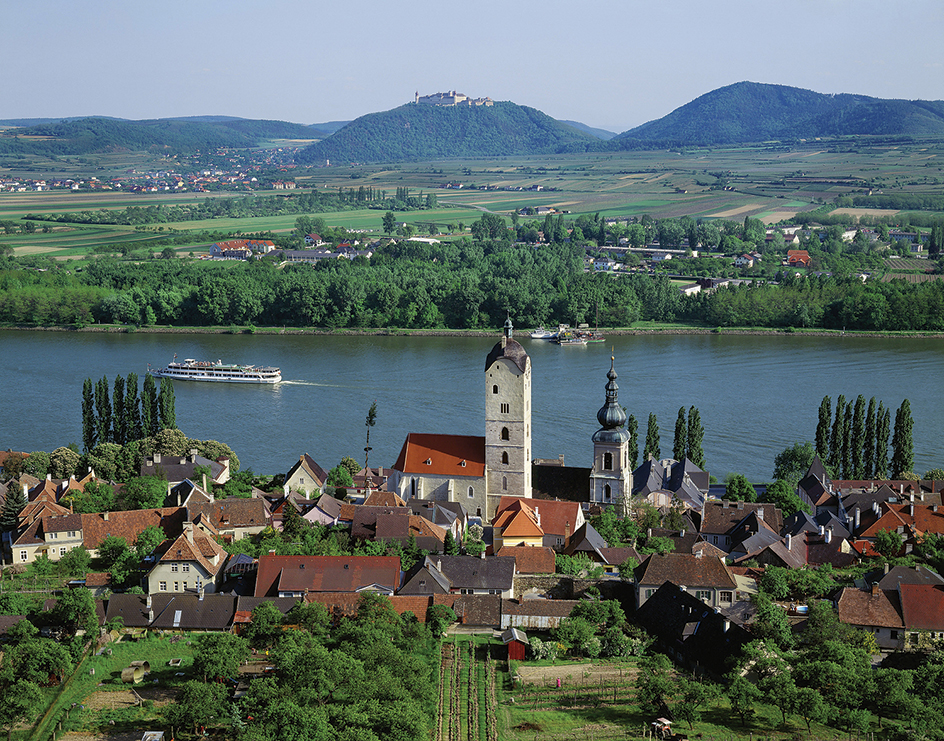
The Danube, the country’s longest river, flows 217 miles (350 kilometers) from west to east through northern Austria. Almost all Austrian rivers flow into the Danube. Austria’s largest lake is Neusiedler Lake. Part of this lake lies in Hungary. The Austrian part covers 52 square miles (135 square kilometers).
Land regions.
Austria has six main land regions. They are (1) the Granite Plateau; (2) the Eastern Forelands; (3) the Alpine Forelands; (4) the Northern Limestone Alps; (5) the Central Alps; and (6) the Southern Limestone Alps.
The Granite Plateau
forms Austria’s northernmost region. It consists of hills and mountains that are made up mostly of granite and partly covered by thick forests.
The Eastern Forelands
lie southeast of the Granite Plateau. The northern part is a lowland called the Vienna Basin. Its fertile soil helps make it Austria’s chief agricultural area. The southern part consists of rolling hills and broad valleys, with the land becoming flatter in the east.
The Alpine Forelands
lie south of the Granite Plateau and west of the Eastern Forelands. The region is made up of hills and low mountains.
The Northern Limestone Alps
rise south and southwest of the Alpine Forelands. The mountains in this region consist of limestone. The region is marked by high plateaus; steep, forested slopes; and jagged peaks. Several large lakes formed by ancient glaciers dot this mountainous region.
The Central Alps
are separated from the Northern Limestone Alps to the north by a series of valleys. Unlike the Northern Limestone Alps, the Central Alps do not consist of limestone but of such rocks as granite and gneiss. The Central Alps have Austria’s highest mountains. Glaciers cover many parts of the mountains. 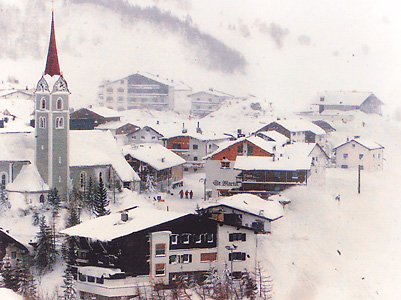
The Southern Limestone Alps
lie south of the Central Alps. A series of valleys separates the two regions. The physical features of the Southern Limestone Alps resemble those of the Northern Limestone Alps.
Climate.
Austria has four sharply defined seasons. The country’s climate is influenced by both west and east winds. Warm, moist winds blowing eastward from the Atlantic Ocean affect the climate of western and central Austria. These winds bring rain, snow, and other forms of precipitation and help produce moderate temperatures throughout the year. Dry winds blowing westward from the Asian plains are hot in summer and cold in winter. Partly as a result of these winds, eastern Austria has less precipitation and more extreme temperatures than western and central Austria.
Within the western, central, and eastern areas, Austria’s climate varies from place to place, partly because of differences in altitude. Local winds also influence the climate. For example, warm, dry winds called foehns cause sudden rises in temperature in some mountain valleys in winter. Because they may rapidly melt mountain snow, foehns sometimes cause destructive avalanches (see Foehn).
January temperatures in Austria average about 27 °F (–3 °C). July temperatures average about 67 °F (19 °C). The country receives an average of about 25 inches (64 centimeters) of precipitation yearly.
Economy
Austria’s economy is based mostly on private ownership of businesses. The country’s economy was severely damaged by the breakup of the Habsburg dynasty in 1918. Wartime destruction and defeat in World War II (1939-1945) brought further economic distress to Austria. However, postwar financial aid from the United States helped boost Austria’s economy.
In the late 1940’s, the Austrian government nationalized (transferred from private to state ownership) most of the companies in several chief industries, including coal and metal mining; electric power production; iron and steel production; and oil drilling and refining. Since the 1980’s, the government has privatized many of these industries, returning them to private ownership.
After the early 1950’s, Austria rapidly became an industrialized nation. Today, service industries have overtaken manufacturing as the country’s leading industry. Austria has become a prosperous country with little poverty or unemployment.
Natural resources.
During the Middle Ages, from about the 400’s to the 1400’s, Austria was famous for its minerals, especially iron from the Erzberg (Iron Ore Mountain) in the Styria province and silver from the Tyrol province. Today, mineral deposits either have become depleted or are too low in quality to meet the country’s needs. The Erzberg still has much iron ore, but Austria must import higher-grade ores. Most of Austria’s petroleum and natural gas reserves are in the Lower Austria province, but these are insufficient for the country’s demands. As a result, Austria depends upon large imports of petroleum and gas.
Austria is one of the world’s leading producers of magnesite, which is used to make such products as heat-resistant bricks and artificial stone. The country also mines gypsum, salt, stone, and tungsten.
Austria’s rich forests, which cover about 45 percent of the country, provide plentiful lumber, paper, and other products. Spruce and fir are commercially important trees. Strict conservation laws and extensive replanting programs ensure the preservation of forests.
Austria’s swift-flowing rivers are another important natural resource. They provide energy for many hydroelectric power stations, which produce more than half of the nation’s electric power.
Service industries,
taken together, account for about 70 percent of both Austria’s employment and its gross domestic product (GDP)—the total value of goods and services produced within a country in a year. The community, government, business, and personal services group employs more people and contributes more to Austria’s GDP than any other economic activity. The privatization of businesses has reduced the government’s influence in the economy, but the state still has total or partial control over several of Austria’s major companies. The finance, insurance, and real estate services group is also important. Many foreign investors own shares in Austria’s banks, and many Austrians have invested in banks in central and eastern Europe. Hotels, restaurants, and shops in Austria benefit from tourism.
Manufacturing.
The production of metal, especially iron and steel, and the manufacture of metal products—including automobiles, locomotives, machines, and tools—once dominated Austrian manufacturing. Today, however, manufacturing has become more varied. Austria’s factories now also produce chemical products, clothing and textiles, electronic equipment, glass and porcelain products, paper, processed foods and beverages, and wood products.
Factories are scattered throughout Austria, but the heaviest concentration is in the Vienna area. There is a strong emphasis in Austrian manufacturing on high quality rather than mass production. Many factories are small or medium-sized. Austria is known for its craftworkers, who produce excellent glassware, jewelry, needlework, porcelain objects, woodcarvings, and other handicrafts. One of the country’s best-known products is Swarovski crystal.
Agriculture.
Austria is so mountainous that only about 20 percent of the land can be used for growing crops. But the country’s farmers use modern machinery and scientific farming methods. As a result, they can supply most of the food needed by the people. All Austrian farms are privately owned. Since the late 1940’s, there has been a trend toward larger farms. But most farms in Austria are still small.
Dairy farming and livestock production are the main sources of farm income. Austria’s farmers produce all the meat and milk needed by the people. The country’s farmers raise beef and dairy cattle, chickens, hogs, and turkeys. Many of these farm animals are raised in the northern section of Austria.
The best croplands are in the Vienna Basin. But farm plots can be found in every province. Austria’s leading crops include apples, barley, corn, grapes, pears, potatoes, sugar beets, vegetables, and wheat. Winemaking is an important industry in Austria.
Tourism.
Austria is one of Europe’s most popular vacation spots. Tens of millions of tourists visit the country every year. About half of Austria’s tourists come from Germany. Many others come from Italy, the Netherlands, and Switzerland. Innsbruck, Kitzbühel, and other sports centers in the Alps attract many winter vacationers, especially skiers. In summer, the lakes of Carinthia and of the Salzkammergut area in central Austria are popular recreation spots. Vienna’s art galleries, concert halls, and museums also attract many tourists, as do the summer music festivals held throughout the country. 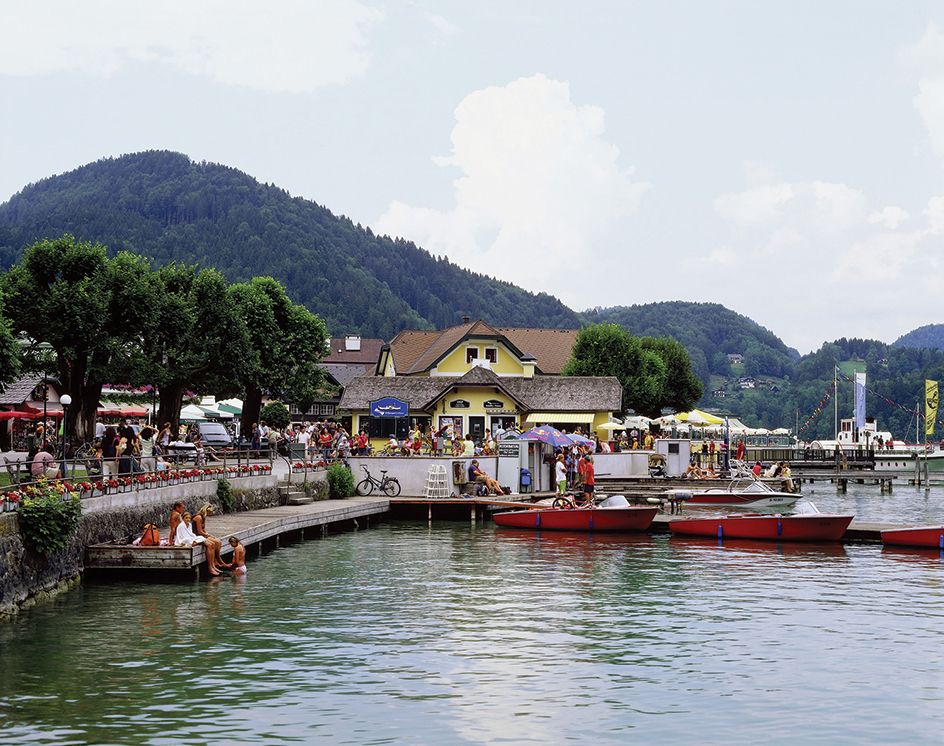
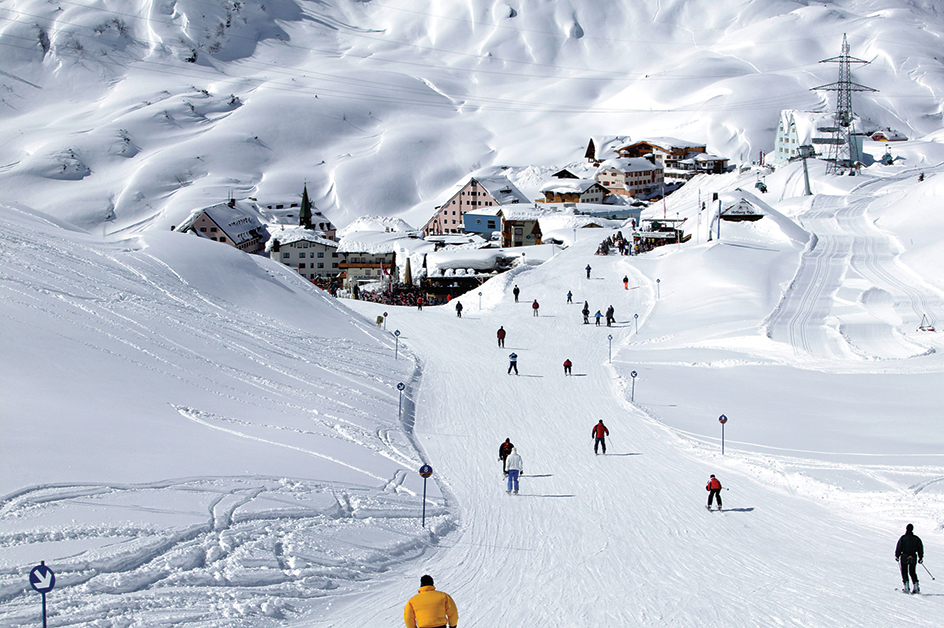
International trade.
Austria depends heavily on trade, especially trade of manufactured goods with other European nations. Austria imports some types of machinery and vehicles and exports other types. Other imports include chemicals, foods, and petroleum. Other exports include forest products, especially paper and pulp, and iron and steel.
Austria’s chief trading partner is Germany. Both countries are members of the European Union (EU). EU members have removed almost all tariffs and other restrictions on imports of manufactured goods from one another. Austria also trades with China, the Czech Republic, France, Italy, Switzerland, the United Kingdom, and the United States.
Transportation.
Austria has an excellent road network. Almost all Austrian families own an automobile. Railroads link almost all cities and towns. The federal government owns most of the nation’s railroad tracks. Both buses and trains provide fast and frequent passenger service. Many mountain areas have cable railways.
Austria’s national airline, Austrian Airlines, operates international and domestic flights. Vienna has Austria’s chief international airport. Graz, Innsbruck, Klagenfurt, Linz, and Salzburg also have important international airports. The Danube River is a major shipping route for trade between Austria and nearby countries. Passenger vessels also travel on the Danube.
Communication.
Austria has many regional and national newspapers. The country’s leading daily newspapers include Kleine Zeitung, Kurier, Neue Kronen Zeitung, and Österreich. Wiener Zeitung, founded in 1703, is one of the world’s oldest daily newspapers. The federal and provincial governments own the nation’s main radio and television stations. Private radio and television stations are also available. People who own a radio or television set pay a license fee. Austria has a high rate of cell phone and internet usage. 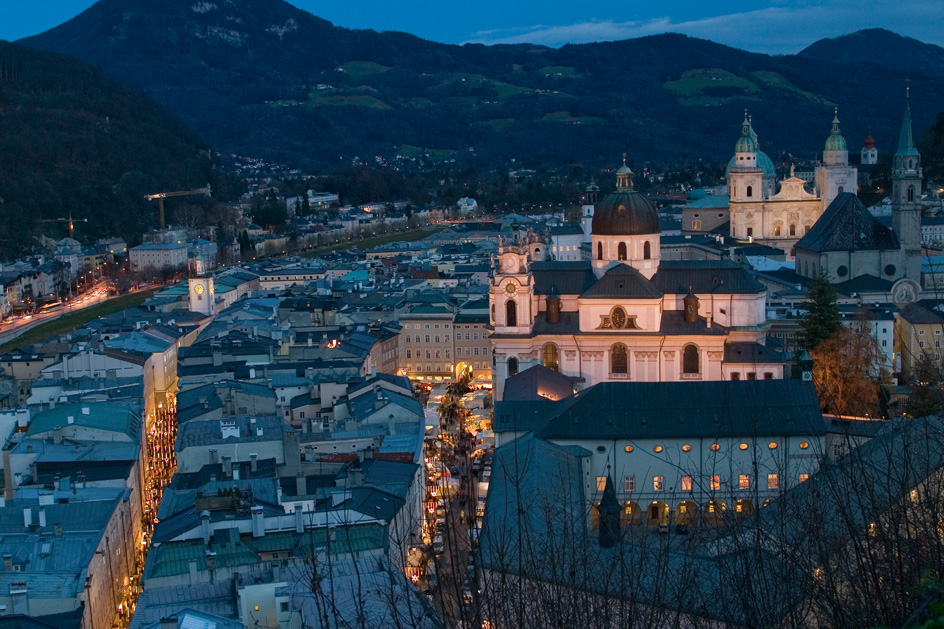
History
Early years.
People have lived in what is now Austria for thousands of years, but historians know little about the earliest inhabitants. They do know that after about 800 B.C., the people mined and traded iron ore and salt. These people were part of a cultural group known as the Celts, which eventually spread through much of central and eastern Europe. Archaeologists have found the earliest evidence of Celtic culture at the village of Hallstatt, near Salzburg.
By 15 B.C., the Romans had made Austria south of the Danube River part of their empire. In the late A.D. 100’s, mainly Germanic tribes from the north began to invade Roman Austria, weakening Roman control. The Roman Empire split into two parts in the late 300’s, and the western part of the empire collapsed in 476. Various groups—including Avars, Slavs, and a Germanic people who became the Bavarians—invaded and settled in Austria.
In the late 700’s, Austria came under the rule of Charlemagne, king of a Germanic people called the Franks. After Charlemagne’s death in 814, the Frankish empire gradually broke up. In the 900’s, Magyars, the national ethnic group of Hungary, overran Austria. But the king of Germany, Otto I, defeated them in 955. Austria then came under his rule. In 962, the pope crowned Otto emperor of what later became known as the Holy Roman Empire. The Holy Roman Empire lasted until 1806. Austria became the empire’s most important state.
In 976, Holy Roman Emperor Otto II had given control of northeastern Austria to Leopold I of the Babenberg family. In 1156, Holy Roman Emperor Frederick I increased the importance of this area by declaring it a duchy. In 1192, the Duchy of Styria, south of the Duchy of Austria, also came under Babenberg rule. In 1238, the Duchy of Austria was divided into two administrative parts, Upper and Lower Austria.
The Habsburgs.
The last Babenberg duke died without an heir in 1246. King Ottokar (also spelled Otakar) II of Bohemia then gained control of the Babenberg duchies of Austria and Styria, plus some lands to the south. In 1273, the princes of Germany elected Rudolf I, a member of the Habsburg family of Switzerland, as Holy Roman emperor. Rudolf defeated Ottokar in battle in 1278 and began to acquire for his family the lands that the king had taken. 
In the early 1300’s, the Habsburgs lost control of the Holy Roman crown. The empire was a patchwork of territories ruled by various families, including the Habsburgs. In 1359, the great-grandson of Rudolf I, Rudolf IV, made a claim, based on forged documents, to the title of archduke of Austria. Other European rulers did not recognize this claim until 1453. In the next few centuries, the Habsburgs acquired many new territories, including most of the regions that make up present-day Austria.
In 1438, a Habsburg had again been elected Holy Roman emperor. From then on, the Habsburgs held the title almost continuously. The House of Habsburg, also called the House of Austria, became the chief dynastic power of the Holy Roman Empire. One of the greatest Habsburgs was Maximilian I. In 1496, he arranged for his son, Philip, to marry the daughter of the king and queen of Spain. Philip’s son became King Charles I of Spain in 1516 and Holy Roman Emperor Charles V in 1519. In 1556, Charles gave up the two thrones. Spain went to his son, and Austria and the title Holy Roman emperor went to his brother, Ferdinand I. The Habsburgs thus became divided into Spanish and Austrian branches.
Ferdinand I had become king of Bohemia and claimed Hungary in 1526. Some Hungarian nobles supported him, and others tried to make a Hungarian nobleman their king. Meanwhile, the Ottoman Empire conquered most of Hungary. Ottoman forces besieged Vienna in 1529 and again in 1683. Both sieges failed. The Habsburgs gained control of almost all of Hungary soon after the 1683 siege.
In 1618, Protestants in Bohemia revolted against their Habsburg ruler, Ferdinand II. Ferdinand was a strong supporter of the Counter Reformation, a movement that led to renewal within the Catholic Church. The Protestants in Bohemia were defeated in 1620. But their revolt led to the start of the Thirty Years’ War (1618-1648), a series of political and religious wars that involved most European nations. The Peace of Westphalia, which ended the war, weakened Habsburg authority in the Holy Roman Empire but strengthened the family’s control over their lands in Austria. The peace treaty declared that the ruler of each state within the empire could determine the religion of that territory. The Habsburgs forced Catholicism on Austria’s large Protestant population.
Wars in the 1700’s and 1800’s.
The last Habsburg king of Spain died in 1700. Both Austria and France claimed the throne. The War of the Spanish Succession (1701-1714) followed. Austria won Belgium and Spain’s Italian lands. A French prince became king of Spain.
Charles VI, the Habsburg heir, became Holy Roman Emperor in 1711. In 1713, Charles publicly announced a decree based on a secret family succession agreement that was made in 1703. Charles added a provision to the ordinance stating that the Habsburg lands should remain united. He also included that, in the event of not having a direct male heir, his daughters’ succession claims should take priority over those of the daughters of his older brother and predecessor, Joseph I. Joseph’s daughters normally would have come before Charles’s daughters in the line of succession. This decree served to strengthen the succession claim of Charles’s prospective children over those of Joseph. Known as the Pragmatic Sanction, this law became especially significant when it became clear that Charles indeed would have no direct male heir. Charles sought and obtained the acceptance of this document, first from the nobles of all of the Habsburg-ruled lands by 1724, and then from the rulers of the principal European states. By doing so, Charles secured the succession of his oldest daughter, Maria Theresa, as the Habsburg heir.
After Charles VI died in 1740, several states challenged Maria Theresa’s right to rule. In the War of the Austrian Succession (1740-1748), Maria Theresa established her rights as ruler of Austria, Bohemia, and Hungary. But she lost nearly all of Silesia to Prussia. In the Seven Years’ War (1756-1763), she tried to regain Silesia but failed. 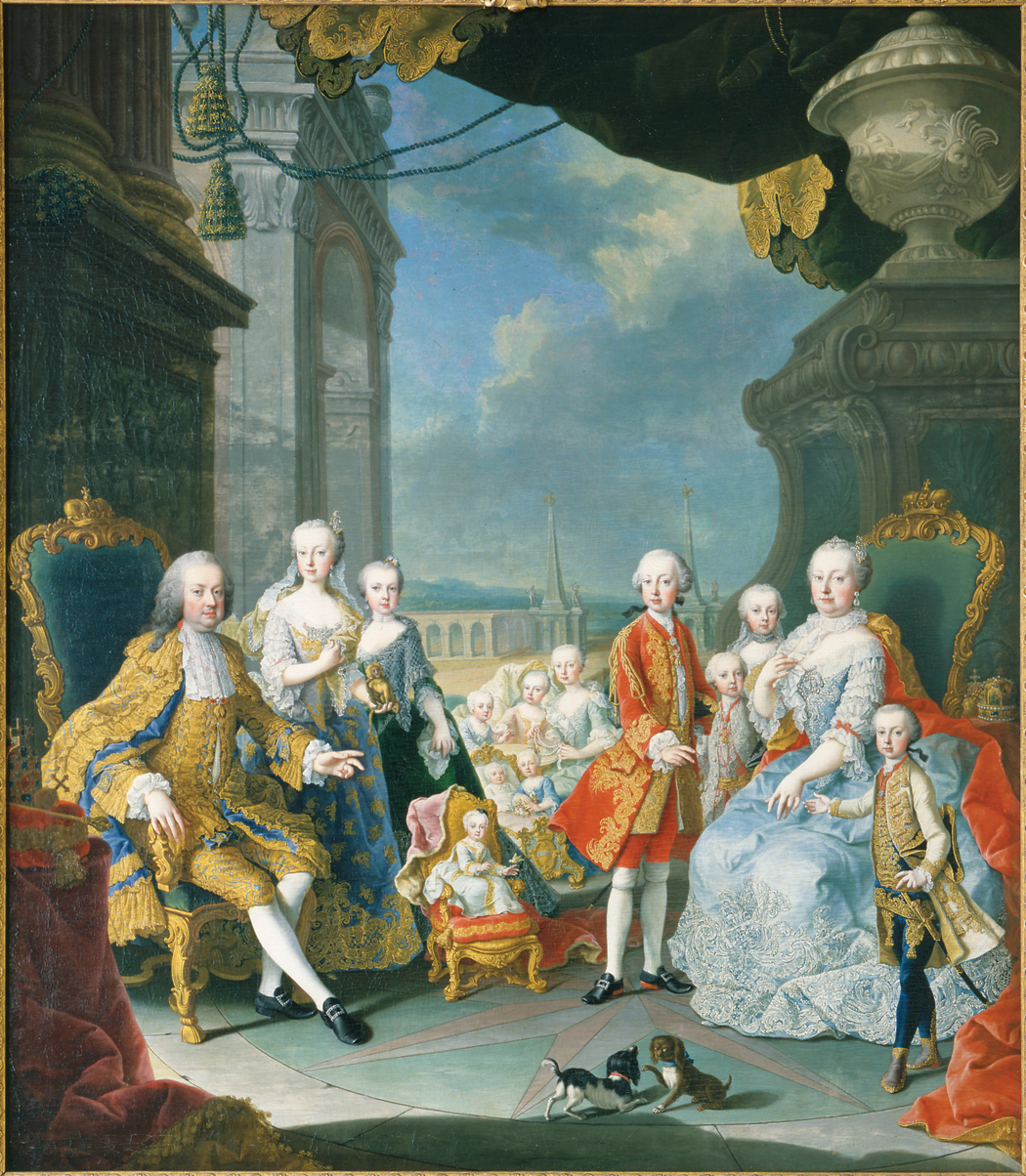
Austria suffered many defeats in the Napoleonic Wars of the late 1700’s and early 1800’s. In these wars, Napoleon I of France fought successfully for many years against an alliance of major European powers, including Austria. Napoleon conquered large parts of the Holy Roman Empire, and in 1806 Emperor Francis II dissolved the empire. Francis had declared himself emperor of Austria in 1804 to ensure that he would still have imperial standing. After 1806, he reigned as Emperor Francis I of Austria. Napoleon was finally defeated in 1815.
Metternich and revolution.
The major political figure in Austria from 1809 to 1848 was Prince Klemens von Metternich, who served as minister of foreign affairs. Metternich played a leading role at the Congress of Vienna. The congress was a series of meetings of European political leaders that arranged the peace settlement following the Napoleonic Wars. The congress returned to Austria most of the land it had lost. Austria exchanged Belgium for Venetia, an area in northeast Italy. The congress also set up the German Confederation, a loose union of independent states. Austria and Prussia began a struggle to lead the confederation.
During the 1800’s, early liberalistic and nationalistic ideas swept across Europe. These ideas, particularly the belief that people had a right to govern themselves, triggered revolutions in many areas of Europe. Because Metternich feared revolution, he tried to put down all nationalist movements in the Austrian Empire. But in 1848, revolution began in France and spread to Austria, Bohemia, the German states, and Hungary. In Vienna, revolutionaries demanded that Metternich resign and that a constitutional government be set up. Metternich fled to England. Revolts also broke out in the Austrian-controlled states in Italy. But by late 1849, the Austrian army had put down all revolts.
At this time, Italy and Germany were not unified countries but were each divided into many small states. In the 1860’s and 1870’s, unification movements in Italy and Germany weakened the Austrian Empire. In Italy, the kingdom of Sardinia, which included the island of Sardinia and the Piedmont region of Italy, led the unification movement. Austria declared war on Sardinia in 1859, but Italian and French forces defeated the Austrians. As a result, Austria lost the Lombardy region of northern Italy and could not prevent Italian unification. In 1866, Prussia used a minor dispute to spark the Seven Weeks’ War, in which Italy and Prussia quickly defeated Austria. Austria had to give Venetia to the new Kingdom of Italy, and the German Confederation was dissolved. Prussia formed a new German empire without Austria.
Austria-Hungary.
In 1867, Emperor Franz Joseph agreed to Hungarian demands for greater autonomy (self-rule) and status. In the resulting Dual Monarchy of Austria-Hungary, both the Austrian Empire and the Kingdom of Hungary were ruled by the Habsburg monarch. The two countries were united in their conduct of foreign, military, and joint financial affairs. But each country had its own government to handle all other matters. 
In the late 1800’s and early 1900’s, Slavs and other minority groups in Austria-Hungary also demanded the right to govern themselves. Serbia led a movement to unite the region’s Slavs. In 1908, Austria-Hungary added the territory of Bosnia-Herzegovina in southeast Europe to its empire. Serbia wanted control of this area because many Serbs lived there. In 1914, Gavrilo Princip, a Serb from Bosnia-Herzegovina, assassinated Archduke Franz Ferdinand, heir to the Austro-Hungarian throne. Austria-Hungary then declared war on Serbia, starting World War I (1914-1918). In this war, the Central Powers—Austria-Hungary, Germany, and other nations—fought the Allies—France, Russia, the United Kingdom, and later the United States. The Allies won the war. 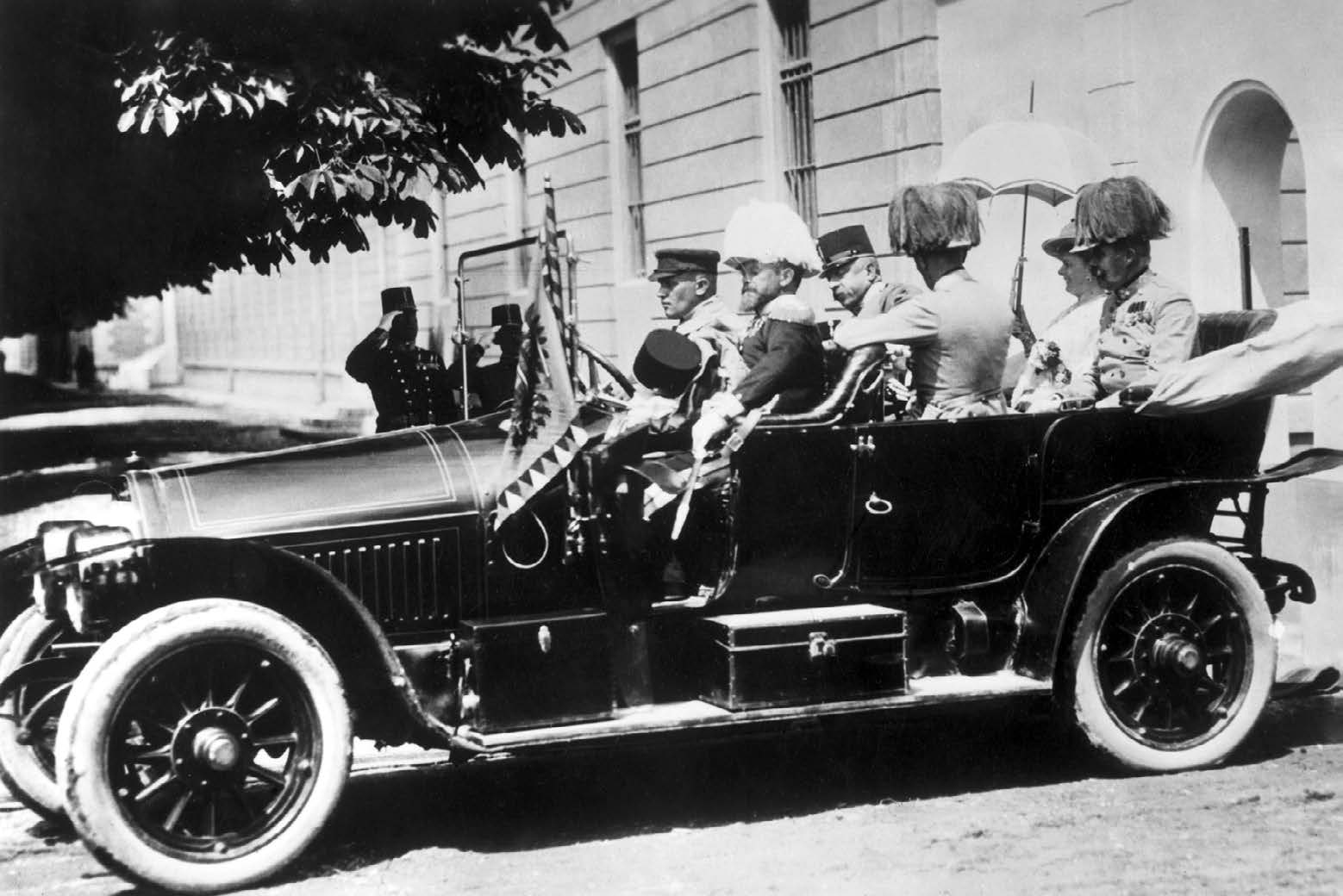
After World War I.
A defeated Austria-Hungary signed an armistice on Nov. 3, 1918. On November 12, the last Habsburg emperor was overthrown, and Austria became a republic. Many Austrians wanted to make Austria part of Germany. But the Treaty of St.-Germain, signed by Austria and the Allies in 1919, forbade such a union. The treaty also established Austria’s present boundaries. In 1920, Austria adopted a democratic constitution.
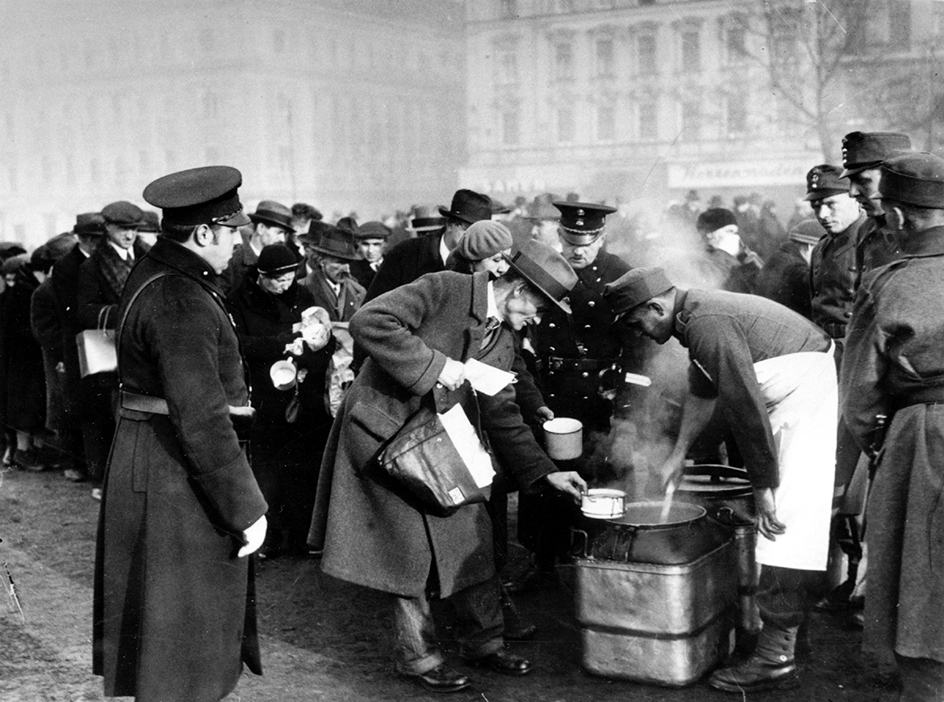
Austria had many political problems after the war. The two major parties—the conservative Christian Social Party and the socialist Social Democratic Party—often clashed with each other. The Austrian Nazi Party also became an increasing menace. In March 1933, Chancellor Engelbert Dollfuss of the Christian Social Party adjourned the Federal Assembly. In February 1934, he outlawed the Social Democratic Party. Dollfuss then ruled Austria as a dictator. However, Austrian Nazis assassinated Dollfuss in July 1934 because of his strong opposition to Adolf Hitler, the Nazi dictator of Germany. Dollfuss was succeeded by Kurt von Schuschnigg, who struggled to maintain Austrian independence against Nazi pressure.
In March 1938, German troops marched into Austria and seized the country unopposed. Hitler then announced the Anschluss (union) of Austria and Germany. Austria became part of Nazi Germany, whose quest for power led to World War II (1939-1945). Hitler’s forces conquered most of continental Europe and, in the “final solution” of the Holocaust, killed about 6 million Jews. Austrians took full part in both the military campaigns and the Holocaust. The Allies, including France, the Soviet Union, the United Kingdom, and the United States, defeated Germany in 1945. 
After World War II,
Austria was divided into American, British, French, and Soviet zones of occupation. But the four powers allowed Austria to set up a single provisional (temporary) government based on the 1920 Constitution. Following elections in November 1945, a national government was formed. It included leaders of both the People’s Party (formerly the Christian Social Party) and the Socialist Party (formerly the Social Democratic Party). This coalition government—that is, a government including two or more parties—helped stabilize Austria. In 1955, the Allies ended their occupation of the country. The Austrian State Treaty of 1955, between the Allies and Austria, guaranteed Austrian independence. To obtain its independence, Austria agreed to be permanently neutral—that is, completely uninvolved in international military affairs. Later in 1955, Austria joined the United Nations (UN).
As a neutral nation, Austria became an important channel for the exchange of ideas between the non-Communist countries of Western Europe and the Communist countries of Eastern Europe. Vienna was the site of some of the Strategic Arms Limitation Talks (SALT) that led to a 1972 treaty between the Soviet Union and the United States limiting nuclear arms. Vienna also became the home of a number of UN agencies.
Austria had coalition governments until 1966, when the People’s Party, led by Chancellor Josef Klaus, won a majority of seats in the Nationalrat. In the 1970 elections, the Socialist Party became the strongest party, though it lacked a majority. The party formed Austria’s first Socialist government, with Bruno Kreisky as chancellor. The Socialists gained a majority in the Nationalrat in the 1971 elections and kept it until 1983.
In the 1983 elections, the Socialists won the most seats in the Nationalrat but fell short of a majority. They formed a coalition with the Freedom Party to keep control of the government. Kreisky resigned as chancellor following the elections. Fred Sinowatz of the Socialist Party succeeded him.
Kurt Waldheim, a former secretary-general of the UN, was elected president of Austria in 1986. During the election campaign, records surfaced indicating that Waldheim might have been involved in Nazi war crimes during World War II. He denied taking part in war crimes, and an investigation found no evidence that he had done so. But he had lied about his wartime record, which led to both domestic and international outrage. After Waldheim’s election, Sinowatz resigned as chancellor and was succeeded by another Socialist, Franz Vranitzky.
Elections in 1986 brought an increase in support for the Freedom Party, which had moved to the far right under the leadership of Jörg Haider. Vranitzky refused to enter a coalition with Haider and instead formed a new coalition government with the People’s Party in 1987. Vranitzky began a policy of facing up to Austria’s past. He became the first Austrian chancellor publicly to accept Austria’s responsibility for war crimes committed when Austria was part of Nazi Germany, from 1938 to 1945. The coalition of the Socialist and People’s parties retained its majority in elections in 1990, 1994, and 1995. In 1991, the Socialist Party changed its name to the Social Democratic Party. Chancellor Vranitzky retired in 1997. Viktor Klima, also of the Social Democratic Party, then became chancellor.
Recent developments.
Elections in 1999 gave Haider’s right-wing Freedom Party the second largest number of seats in the Nationalrat. In 2000, the conservative People’s Party formed a coalition with Haider’s group. In 2006, Nationalrat elections led to a coalition between the Social Democratic Party, led by Alfred Gusenbauer, and the People’s Party. Gusenbauer then became chancellor. In 2008, Werner Faymann succeeded Gusenbauer as Social Democrat leader and as chancellor at the head of a new coalition government.
In 2015, Austria began accepting large numbers of refugees fleeing war and terrorism in the Middle East and northern Africa. In national elections in 2016, anti-immigrant sentiment resulted in advances for the far-right Freedom Party. In May, Faymann resigned as chancellor and as Social Democratic Party leader. Railway executive and businessman Christian Kern was named Austria’s new chancellor and leader of the Social Democrats.
Following parliamentary elections in late 2017, the People’s Party formed a coalition with the Freedom Party. People’s Party leader Sebastian Kurz became Austria’s new chancellor. Kurz resigned in May 2019, following a political scandal involving leaders of the Freedom Party, his coalition partner. Brigitte Bierlein, the president of the Constitutional Court, became interim (acting) chancellor. In September elections, the People’s Party won the most seats in the Nationalrat. In January 2020, the People’s Party formed a coalition government with the environmentalist Green party, and Kurz returned as chancellor. The new government pledged to reduce taxes, maintain a hard-line stance on immigration issues, and pursue investments in public transportation and renewable sources of electricity.
Beginning in 2020, Austria faced a public health crisis as a result of the COVID-19 pandemic. COVID-19, a contagious respiratory disease, first broke out in China in late 2019. It soon spread around the world and caused outbreaks throughout Europe. Austrian authorities imposed a national lockdown on March 16, 2020, closing many businesses and issuing social distancing guidelines. In April, authorities ordered the wearing of face masks in shops and on public transport. The government later increased or relaxed business and social restrictions based on changes in infection rates. In 2021, the distribution of COVID-19 vaccines became a major focus of government efforts to combat the disease. Higher vaccination rates generally led to lower infection and death rates, but outbreaks continued to occur. By early 2023, about 6 million COVID-19 infections had been recorded in Austria, and more than 20,000 Austrians had died.
Kurz resigned as chancellor in October 2021 after an investigation alleged that he had used public money to pay journalists and a polling company for positive press coverage. Foreign Minister Alexander Schallenberg briefly replaced Kurz as chancellor. After Kurz resigned from politics in December, Interior Minister Karl Nehammer was elected party leader and named chancellor.
